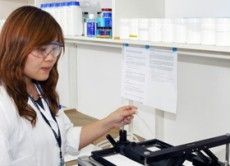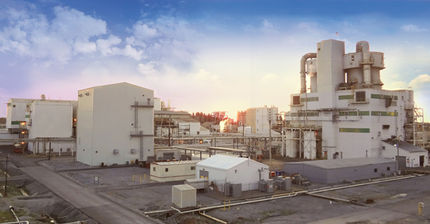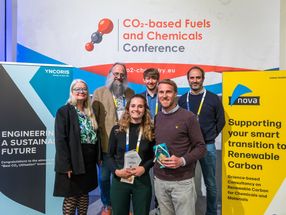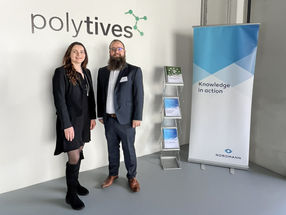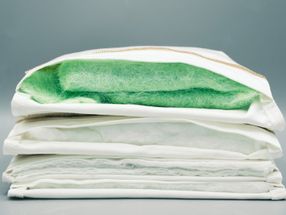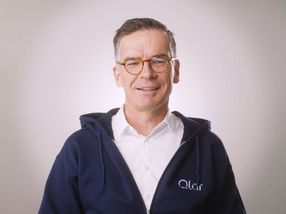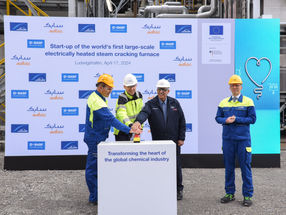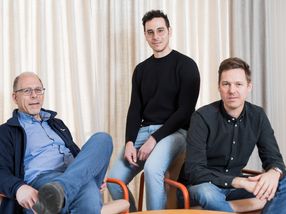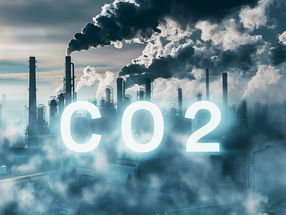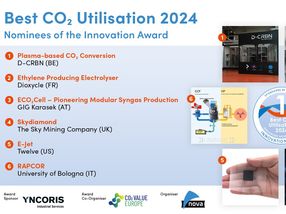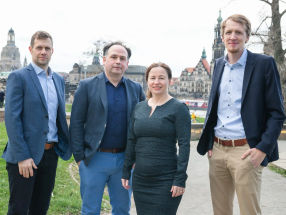WACKER expects further sales and earnings growth for 2018
As already reported, Wacker Chemie AG met or surpassed its own projections for all its performance indicators in 2017. On presenting its annual report, the Munich-based chemical company announced that Group sales reached €4.92 billion, up 6 percent year over year (2016: €4.63 billion). The rise was mainly due to higher volumes in chemicals and in polysilicon. As a result, WACKER more than compensated both for negative currency effects due to the euro’s strength against the US dollar and for prices that, on balance, were somewhat lower.
EBITDA (earnings before interest, taxes, depreciation and amortization) totaled €1,014.1 million in 2017 (2016: €955.5 million). That was a year-over-year increase of 6 percent and yielded an EBITDA margin of 20.6 percent (2016: 20.6 percent). This growth was mainly prompted by higher sales, by a very good operating performance, and by income of €40.0 million from the company’s stake in Siltronic. On the other hand, raw-material costs were higher year over year and dampened earnings.
Group EBIT (earnings before interest and taxes) rose strongly last year, up 26 percent to €423.7 million (2016: €337.5 million). This corresponds to an EBIT margin of 8.6 percent (2016: 7.3 percent). Lower depreciation year over year had a positive influence on EBIT and amounted to €590.4 million in 2017 (2016: €618.0 million).
Income from continuing operations climbed 40 percent in 2017 to €250.1 million (2016: €178.1 million). The Group’s net income for the year was €884.8 million (2016: €189.3 million). It included €634.7 million in income from discontinued operations from Q1 2017. This amount comprised both the gain associated with the deconsolidation of Siltronic AG as a WACKER Group segment and Siltronic’s net income in the first quarter of 2017.
In 2018, WACKER intends to continue the good performance of last year, despite strong currency headwinds. Currency effects and amendments to accounting standards are expected to reduce sales by an amount in the low-triple-digit millions. Nonetheless, WACKER aims to lift its full-year sales by a low-single-digit percentage. Group EBITDA is projected to rise by a mid-single-digit percentage compared with 2017. As for net income from continuing operations, WACKER expects a marked increase.
During the first two months of the current year, WACKER’s chemical business performed well. Over this period, total chemical-division sales were clearly above the prior-year figure. On the other hand, polysilicon sales for the first two months were noticeably lower than a year ago because less material was available for sale as a result of the production shutdown at Charleston. For Q1 2018, WACKER expects total Group sales to be on par with last year (Q1 2017: €1.22 billion). Group EBITDA in Q1 2018 is likely to be substantially higher than a year ago because earnings are supported by better prices for silicone products, by high plant utilization, and by increased income from the stake in Siltronic AG.
“WACKER’s prospects remain bright,” said Group CEO Rudolf Staudigl in Munich on Tuesday. “Demand is very high in all our business fields. Our chemical operations will continue to grow this year. In our polysilicon business, we currently lack Charleston’s output, but, in all likelihood, we can begin ramping up our facilities there in a few weeks’ time. All in all, Group sales will not grow as dynamically this year as in 2017, but we expect earnings to rise markedly.”
Capital Expenditures
In 2017, the Group’s capital expenditures amounted to €326.8 million (2016: €338.1 million). That was 3 percent less than the year before.
An investment priority last year was capacity expansion at WACKER’s three chemical divisions. At the Jincheon site in South Korea, new facilities were built for manufacturing silicone sealants and specialty silicones. These products are used in the construction, electronics and automotive industries. In Burghausen, Germany, a new dispersion reactor expanded WACKER’s polymer operations there. It went on stream in Q4 and has an annual capacity of 60,000 metric tons.
In 2017, WACKER launched a number of other investment projects. They include new plants for dispersions and dispersible polymer powders at the Ulsan site (South Korea), construction of a new production facility for pyrogenic silica in Charleston (USA) and silicon-metal capacity expansion at Holla (Norway). At Léon (Spain), WACKER is modernizing a large-scale fermentation plant acquired in 2016. Bio-engineered cystine for the food and pharmaceutical industries is to be produced there.
Employees
Increasing chemical-division sales expanded the Group’s workforce. The number of employees rose by around 360 in 2017. As of December 31, 2017, WACKER had 13,811 employees worldwide (Dec. 31, 2016: 13,448). Its German sites had 9,984 employees (2016: 9,775) and its international sites 3,827 (2016: 3,673).
Net Cash Flow, Net Financial Debt and Equity Ratio
WACKER again generated a high cash inflow in 2017. At €358.1 million (2016: €361.1 million), net cash flow from continuing operations was on par with the prior year and, thus, even somewhat better than the last forecast. This result was positively influenced by substantially lower cash payments for capital expenditures. The Group’s net financial debt amounted to €454.4 million as of December 31, 2017 (Dec. 31, 2016: €992.5 million). That was 54 percent less than the year before. WACKER’s total assets on December 31, 2017 amounted to €6.84 billion (Dec. 31, 2016: €7.46 billion). The main reasons for this 8-percent decline were the deconsolidation of Siltronic and a reduction in fixed assets due to depreciation. Group equity rose strongly year over year. It amounted to €3.17 billion on the reporting date (Dec. 31, 2016: €2.59 billion). The resulting equity ratio was 46.4 percent (Dec. 31, 2016: 34.8 percent). The increase essentially reflected the year’s high net income.
Business Divisions
In 2017, WACKER SILICONES posted substantial sales growth. Climbing 10 percent, its sales reached €2.20 billion (2016: €2.00 billion). The rise was due to volume gains and somewhat higher prices. EBITDA growth outpaced sales gains year over year. EBITDA climbed 23 percent to €444.9 million (2016: €361.2 million). This trend was driven by strong volume growth, by somewhat higher prices in several product groups, by high plant utilization and by good cost efficiency.
WACKER POLYMERS’ sales rose 4 percent in 2017 to €1.25 billion (2016: €1.19 billion). Growth was fueled by higher volumes for dispersions and dispersible polymer powders. Lower prices and negative currency effects dampened sales performance. EBITDA of €205.6 million was 21 percent below the year-earlier level (2016: €261.0 mil-lion). A key factor here was the strong increase in raw-material prices.
At WACKER BIOSOLUTIONS, sales of €205.9 million were on par with the year before (2016: €206.4 million). While the division sold higher volumes, slightly lower prices and negative currency effects had a contrary impact. EBITDA of €37.5 million (2016: €37.0 million) was marginally higher than the year before.
Sales at WACKER POLYSILICON climbed 3 percent in 2017 to €1.12 billion (2016: €1.10 billion). Growth was due to a strong rise in volumes despite lower average prices. Prospects of stronger volume and sales growth were impeded by the loss of production at Charleston in the USA. On September 7, 2017, a technical defect led to a hydrogen explosion there, which damaged a plant section. Production had to be shut down. As a result, WACKER POLYSILICON had a shortfall of around 6,000 metric tons of polysilicon that would have been available for sale. EBITDA amounted to €290.4 million, rising by 2 percent (2016: €285.9 million). This gain mainly stemmed from higher sales and a decline in production costs.
Proposal on Appropriation of Profits
In 2017, Wacker Chemie AG posted a retained profit according to German Commercial Code accounting principles of €1,502.4 million. The Executive and Supervisory Boards will propose a dividend of €2.50 per share for 2017 (2016: €2.00) at the Annual Shareholders’ Meeting. In addition, they will propose an extra €2.00 per share in connection with not only the sale of Siltronic shares and the very good net-financial-debt trend, but also the positive prospects for the company. Based on the number of dividend-bearing shares as per December 31, 2017, the total cash dividend corresponds to a payout of €223.5 million. Calculated in relation to WACKER’s average share price in 2017, the dividend yield is 4.0 percent.
Outlook
Economists expect the global upswing to continue in 2018 with increasing momentum.
WACKER sees good opportunities for further growth in its chemical business this year. Sales at all three chemical divisions are expected to climb. At WACKER SILICONES, the forecast is for a low-single-digit percentage increase. At WACKER POLYMERS and WACKER BIOSOLUTIONS, sales are likely to grow by a mid-single-digit percentage.
EBITDA at WACKER SILICONES is projected to rise by a mid-single-digit percentage year over year, amid higher prices for some raw materials. WACKER POLYMERS anticipates EBITDA at the prior-year level, since raw-material prices are likely to continue rising and because there will be a scheduled production shutdown in the second quarter. At WACKER BIOSOLUTIONS, integration costs for the new site in Spain will impact 2018’s EBITDA, which will be significantly lower than last year.
In its polysilicon business, given the present production shutdown at Charleston, WACKER’s 2018 forecast is that volumes will be at last year’s level, amid lower average prices for polysilicon. Consequently, sales are expected to fall below last year’s figure by a high-single-digit percentage. EBITDA is projected to climb slightly year over year, supported by the continued success of cost-cutting measures, and taking account of insurance compensation.
Overall, WACKER anticipates further increases in raw-material prices in 2018 and headwinds from a stronger euro against the US dollar. Given these underlying conditions, Group sales are projected to climb by a low-single-digit percentage. EBITDA should grow further, up by a mid-single-digit percentage versus last year. WACKER expects its EBITDA margin to be slightly higher than a year ago. At around €470 million, capital expenditures will rise substantially compared with last year, mainly to support growth at WACKER SILICONES. Depreciation of about €550 million will be significantly lower than a year ago. WACKER expects Group net income from continuing operations to rise markedly. Net cash flow is forecast to be clearly positive, but substantially below last year’s figure, due to higher capital expenditures. Net financial debt will remain on par with last year.
